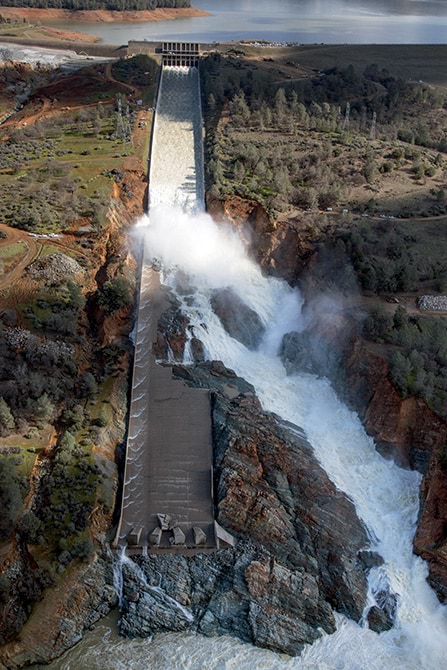
Reinforcing the Oroville Dam Spillway in California
Mapei product helped to strengthen a dam’s structure and save a city: when devastating amounts of erosion were discovered on the Oroville Dam’s spillway, thousands of lives were at risk.
The dam had to be reinforced before the rains began again and the water levels in the lake started to rise.
Mapei Corp.’s PLANIGROUT 755 grout (whose counterpart on the international market is called MAPE FILL) was utilized to fill voids in the concrete and strengthen the repaired structure which contributed to help the town.
Mapei product helped to strengthen a dam’s structure and save a city.
The state of California had a massive problem.
Decades had passed with public funds being diverted away from infrastructure projects, resulting in deteriorating freeways and roads, rusting bridges and – as the normally drought-ridden state learned during one rainy winter – crumbling dams.
February 2017 was an unusually rainy season, soaking Northern California to saturation and beyond. On February 7, as the water continued to pou rdown, state engineers noticed concrete erosion on the flood-control spillway at the Oroville Dam. In operation since 1968, the Oroville Dam is an earth-fill embankment dam located on the Feather River just east of the city of Oroville, California (population 19,895) in Butte County (population 220,400) in the scenic Sierra Nevada foothills. At 235 m highand 2,109 m long with a volume of 59,635,279 m3, the Oroville Dam is not only the tallest dam in the United States, it is the only thing separating Lake Oroville from the thousands of people living downstream in Oroville.
As additional storms were being predicted, engineers inspected the spillway further and uncovered more erosion. Finally, the California Department of Water Resources stopped the spillway flow and the worst was revealed: the structure was badly damaged and in need of immediate repair.
An emergency spillway was created, and the water flow was diverted to it. Rocks were carried by helicopter to the damage site to help shore up the erosion but, like a scene from a nightmare, the effort was no match for the rising water.
At that point, state officials issue devacuation orders for 200,000 people living downstream. The idea of the dam failing and sending Lake Oroville crashing downhill overrev erything in its path – including the town of Oroville – was turning into more of a reality. California’s massive problem had become a state of emergency.
Heavy equipment and construction workers were called in from around the state. As water continued to pour from the emergency spillway, over 125 crews worked around the clock in an attempt to lower the lake level.
Finally, by February 17 (10 days after the erosion was first noticed), the crews were ready to begin pouring concrete and Mapei Corporation., the U.S. subsidiary of the Group, was there to help.
PLANIGROUT 755: Dam right
“There was one product for this job,” said Rob Dyer, the Mapei coordinator on the project. “They knew it would work. We knew it would work. And so, there was a lot of PLANIGROUT 755 delivered to this jobsite.”
The specifications called for the installation of about 8,000 pieces of no.10 rebar on the spillway to reinforce the heavily eroded structure. “Each piece of rebar was sized between 4.57 and 7.62 m in length,” Dyer said.
PLANIGROUT 755 is a one-component, non-shrinking, cementitious grout. This product is manufactured and distributed on the U.S. market by Mapei Corp. (its counterpart on the international market is calledMAPE FILL).
The product was excellent for use as non-shrink grout for rebar placement. About 8,000 cores were drilled. Rebar was then placed into the cores. “We pumped PLANIGROUT 755 in to fill the voids between the pieces of rebar and the outer wall of the core,” Dyer said. “We used about 16,000 bags of 22.7-kg product during the entire project.”
Fortunately, the rains held off and the water levels in the lake dropped during the repair process. “This minimized the possibility of a dam failure during the quick fix on the damaged spillway and then on the repair/replacement that immediately followed,” Dyer said. Dyer then summed up the incredible experience. “This was a great project to be a part of. How often do you get the chance to help save an entire town?”
This article was taken from Realtà MapeiNorth America, no. 30, the in-housemagazine published by Mapei Corp.,whom we would like to thank. For further information see www.mapei.us.








